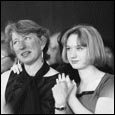Celebrating the Life and Legacy of Nuclear Chemist Glenn Seaborg
By Kathleen Scalise, Public Affairs
Posted March 31, 1999
 Glenn Seaborg's daughter, Lynne Seaborg Cobb, with her daughter, Molly Cobb. Noah Berger photo. |
"We stand in awe of this man," said C. Judson King, Office of the President provost and senior vice president of academic affairs.
King and 16 other speakers described the life and legacy of Berkeley's most famous nuclear chemist, who discovered 10 atomic elements, including plutonium. As the namesake of "seaborgium," he was the only living scientist to have an element named in his honor.
Seaborg's illustrious career also included tenures as Berkeley professor and chancellor, chair of the Atomic Energy Commission, advisor to 10 U.S. presidents and national crusader for excellence in science education.
Seaborg's son, David, who delivered the eulogy, remembered his father, who died Feb. 25 at the age of 86, as a man of peace.
"He worked ceaselessly to limit the arms race when he was head of the Atomic Energy Commission," he said. "He worked very hard for peace in a nuclear era."
The memorial event in Zellerbach Hall was preceded by a "circle of sharing" in the Martin Luther King Jr. Student Union, where several hundred friends and colleagues shared remembrances of Seaborg. Their comments were testimony to Seaborg's enormous influence even outside of science.
Teachers applauded Seaborg for his work on the influential 1983 national education report, "A Nation at Risk," which told how to rectify serious schooling problems.
"He's a 20th century hero," said an educator from Los Angeles.
Others thanked Seaborg for his efforts to avert nuclear war.
"I am a survivor of the Hiroshima atomic bomb," said Thomas Tanemori of Layfayette. "...Not only did Dr. Seaborg help discover such power as the atomic bomb, that changed the course of human history, but he desired not to use it on populated areas."
Tanemori described how Seaborg wrote to President Harry Truman at the end of World War II to deter him from dropping the atomic bomb on Japan, suggesting that he first demonstrate the weapon to the world on a barren island.
"I see that Dr. Seaborg had a heart of peace," said Tanemori.
Calling the Swedish-American scientist an "incomparably good human being," Barbro Osher, the consul general of Sweden, claimed Seaborg for her country.
"You Americans always think he belongs just to you," she said, drawing chuckles from the crowd.
The Navajo Nation thanked Seaborg for helping to establish a science center in the Navajo community. Fred Begay, on behalf of the Navajo tribal government, presented the Seaborg family with the Navajo flag at the reception following the memorial.
Even legendary Berkeley sports figures, including former quarterback Joe Kapp, turned out in honor of Seaborg, who was chancellor during Cal's 1959 Rose Bowl appearance.
"If you rearrange the letters of Seaborg's name, you get 'Go Bears,'" said one team member. "Cal has lost an institution."
![]()
![]()
March 31 - April 6, 1999 (Volume 27, Number 28)
Copyright 1999, The Regents of the University of California.
Produced and maintained by the Office of Public Affairs at UC Berkeley.
Comments? E-mail berkeleyan@pa.urel.berkeley.edu.